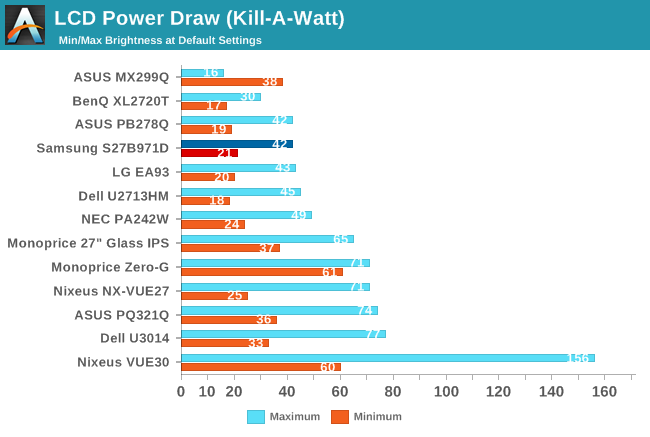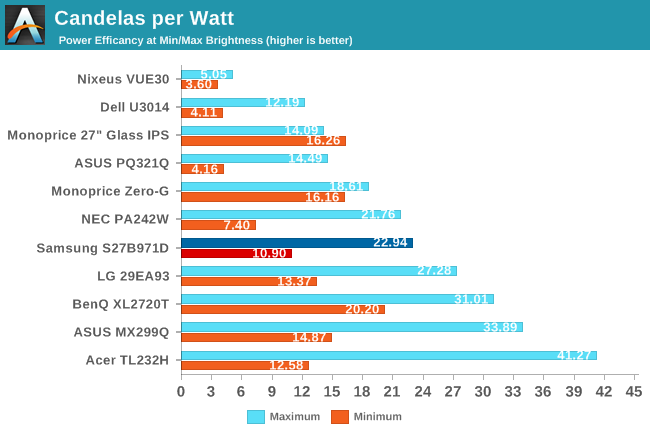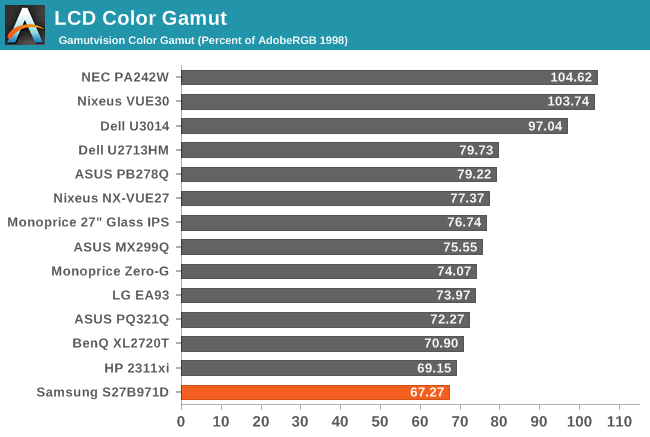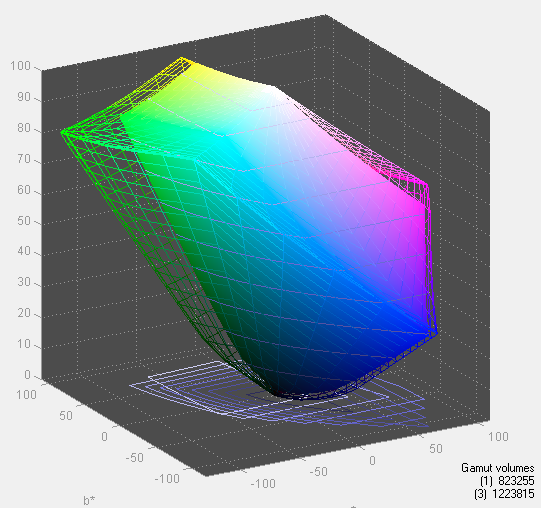Samsung S27B971D Monitor Review
by Chris Heinonen on October 31, 2013 12:00 PM ESTInput lag is tested over HDMI using the Leo Bodnar lag tester. It is limited to 1080p but it provides consistent, repeatable results that anyone can duplicate. A scaler can also be designed to introduce very little lag if implemented correctly so native resolution might provide better results, but it would be a slight difference (unless a poor/slow scaler is used).
Tested this way the Samsung S27B971D averages 26.3ms of lag. This is competitive with other 27” WQHD monitors that have produced 22.53 – 35.97ms of lag. Basically if you find any 27” WQHD monitor to be too slow, the Samsung won’t change your mind. I found nothing wrong with the overall gaming performance in my testing.

Power Use
Power draw from a Kill-A-Watt is reasonable on the Samsung with 21 watts at minimum backlight and 42 watts at maximum. On a candelas-per-square-inch-per-watt basis it comes in as being one of the most efficient monitors at maximum backlight and middle of the pack at minimum backlight. Now that virtually everyone uses LEDs, even for wide gamut displays, there probably won’t be as much difference here as there used to be.


Color Gamut
This is a bit interesting to me. In the sRGB mode the Samsung S27B971D falls short of the full sRGB gamut. It fills 67% of the AdobeRGB gamut, and not the 69% that we expect from sRGB. It’s a small difference but it is still a difference. If we switch to the standard color mode instead of sRGB then the gamut is larger. I ran the pre-calibration numbers, did a calibration in both modes, and ran the post-calibration numbers and found that the sRGB preset was far superior in the end. So while the gamut might come up just slightly low, it’s better than being over-saturated all around. In practice, very few people if any will notice the difference between 67% and 69%, as what we’re really looking for are displays that use significantly less than the sRGB gamut.












52 Comments
View All Comments
hbsource - Thursday, October 31, 2013 - link
As someone once said, 'There's no such thing as a bad product, just bad pricing.' That seems to be the case here.Da W - Thursday, October 31, 2013 - link
For that price i got 3 ASUS PA248Q monitors, which are pretty good.hero1 - Thursday, October 31, 2013 - link
Tell me about it. That is way more than the Dell U2713HM that I have. Samsung screwed up here.Silma - Saturday, November 2, 2013 - link
Very happy with the Dell U2713HM, far less expensive and superior in almost all ways to the Samsung.Gothmoth - Saturday, November 2, 2013 - link
the dell 2713HM is complete crap fro real work.it´s a gaming monitor but no match for people who need a good colormanaged monitor.
no sane person intersted in accuracy would use the dell over a eizo or nec.
the samsung is better then the dell but no match to eizo or nec monitors aroun 1000 euro.
wavetrex - Sunday, November 3, 2013 - link
Who said every monitor must be for GRAPHICS work ?I can work my programming just fine on the 2713HM and do everything else on the computer without noticing any real "color" problems. Excellent monitor for the price !
This Samsung however breaks the bank. 27" WQHD really need to come down in price, not up...
cheinonen - Friday, November 1, 2013 - link
The PA248Q is only 1920x1200 so Apples to Oranges, but yes the price is wrong. If the measured performance had matched the data sheet, it would have worked at $1,000 for a certain audience. That after a WQHD display with really accurate color and uniformity but that doesn't need a color gamut beyond sRGB. As the post-calibration numbers show, it is capable of very high performance.Unfortunately it didn't meet that. I don't know if mine was a bad sample or if they measure a different way, but it didn't hit the level of performance the price point would require. It's a nice display, I've been using it post-calibration and it's really great, but most people lack $1,000+ in calibration gear to bring out that performance. Hopefully Samsung can get it right in the next generation, because it has a lot of potential.
deeps6x - Friday, November 1, 2013 - link
"The PA248Q is only 1920x1200.."Quite frankly I'd rather have the extra 120 pixels in screen height than the higher resolution.
2560 x 1600 monitors please.
Bakes - Friday, November 1, 2013 - link
I have to agree with you. I think 16:10 just seems more usable. I don't mind that movies are letterboxed.Death666Angel - Friday, November 1, 2013 - link
Have you used a 27" 1440p monitor? Sure, 1600p is great, but they usually cost twice as much and there is much less competition. I came from a 24" 1920x1200 monitor to a Samsung S27A850D (luckily without the complaints many people had with it, lots of backlight bleed and other stuff), and the narrower picture doesn't really bother me, the higher resolution in all axes is much more important for me. And since Win7 with the easy side-by-side view of applications, productivity is even higher.